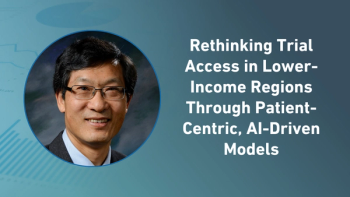
- Applied Clinical Trials-05-01-2022
- Volume 31
- Issue 5
Patient Recruitment Goes High-Tech
Emerging tools in data analytics, automation, EMR aggregation, and even social media are enabling faster and easier patient recruitment.
Patient recruitment has long been a challenge for clinical trial investigators, with low recruitment being the single-largest cause of terminated trials. One 2015 analysis found that 19% of all clinical trials are terminated early due to poor recruitment. In the US, one study of 41 NIH-registered clinical trials found that only one-third of studies meet their patient recruitment goals. This same study found that as many as 24% of all NIH-registered trials fail to get even halfway to a full patient sample.
Clinical trial patient recruitment is arguably the most difficult aspect of pharmaceutical development, because it involves a variety of factors beyond study sponsors’ control. Yet in spite of this lack of control, sponsors, investigators, and service providers are finding creative new ways to identify and recruit patients that are made possible through advances in medical technology.
The COVID-19 pandemic has accelerated the adoption of these technologies, and now, the innovators and disruptors responsible for creating patient recruitment tools say further tech advancements and refined processes will dissolve barriers to trial participation and accelerate research. Here are some of the emerging new ways that sponsors and contract research organizations (CROs) are conducting patient recruitment.
EMR data aggregation facilitates rare disease research
Patient recruitment challenges have long hamstrung rare disease research. Now, though, direct-from-electronic medical record (EMR) patient recruitment technology is enabling trial administrators to locate rare disease patients anywhere in the world. Jason Baumgartner, MBA, is the founder and CEO of BEKHealth in New York City. BEKHealth is a software company that manufactures EMR data processing, feasibility, site selection, and patient-trial matching software. Baumgartner says that EMR aggregation is enabling investigators and sponsors to rapidly identify patients with rare diseases, a pool of patients traditionally difficult to find.
"Just yesterday, we had a company send us a protocol,” Baumgartner tells Applied Clinical Trials last month. “Through our network of research sites, we identified about 100 patients. Technologies that can evaluate entire networks of practices with a high level of precision, that enable CROs to tell the drug companies how many patients are in which locations in a centralized manner, that’s what’s emerging.”
Baumgartner notes that patients are often rendered ineligible for studies as a result of medication history or comorbid conditions. In the past, he says, out-of-date or incomplete information has often resulted in prospective patients being dropped from studies due to previously unknown comorbid conditions or medication histories. With rare diseases, in particular, researchers may face the added challenge of trying to locate patients without having an ICD-10 code. Now, though, recent advances in EMR technology have enabled investigators to conduct a type of predictive analytics called disease modeling. By aggregating various pieces of medical data into one centralized repository and then analyzing that data, emerging new technologies can predict whether or not a given patient has a particular rare disease—no ICD-10 code needed.
“The EMR as a source of truth is becoming the mandate,” says Baumgartner. “I’d say that within five years, most research and health institutions will be leveraging automation to do research. If you look at an 80-hospital health system, they might be using 20 EMR systems. The aggregation of data across 80 hospitals and 20 systems, for the purpose of understanding patients, doing feasibility studies, or engaging in decentralized recruitment, is the trend we’re seeing.”
Baumgartner predicts that in the near future, feasibility studies and recruitment will no longer be coordinated at the hospital level. Rather, aggregated EMR solutions will enable feasibility and recruitment to be their own centralized functions. Today, though, he says the most exciting development in recruitment technology is metadata.
“There are multiple products that exist today that will tell you in real time how many patients have been identified for your study,” he says. “But reports are now existing that provide metadata around why specific patients are, or are not, being considered for a study—which criteria are knocking patients out of the trial. Organizations are also getting direct feedback from clinical research staff about why the patient isn’t a good fit. That information is becoming more available to sponsors, which enables better collaboration.”
EMR data aggregation and modeling are also helping investigators and sponsors to create a more individualized and welcoming patient experience. The benefits of this individualized approach are most immediately noticeable at community sites, such as a pharmacy. Baumgartner says pharmacies have unique and growing data sets that typically rely on prescription data to determine whether patients may be eligible for studies, but this approach can be problematic. When recruiting using prescription data alone, it isn’t always clear which condition the patient has.
“A depression drug may not be used to treat depression,” explains Baumgartner. “It may have been prescribed for anxiety. Or Crohn’s disease versus [irritable bowel syndrome]. You can’t have people show up to a pharmacy and get a text or call about a disease they don’t have. So how do you use predictive disease models to determine what disease a patient has when their medication is indicated for four different conditions?”
BEK Health has solved this problem by aggregating EMR data from 25 million patients into approximately 2,000 disease models. Baumgartner says that for about 1,000 of those models, BEK Health can predict with 90% accuracy which disease the patient has. It’s this type of predictive analytics that Baumgartner claims can help to improve both individual access to clinical trials and enhance the patient experience during a study. (Listen
Social media effective with younger patients
Investigators and CROs were dabbling with social media for trial recruitment long before the COVID-19 pandemic, but it wasn’t until the pandemic shut down study sites that social media became a viable strategy at scale. Nimita Limaye, PhD, is the vice president of research for the life sciences R&D strategy and technology division at the International Data Corporation (IDC), a market research and advisory firm specializing in the technology industry and headquartered in Boston, Mass. Limaye says social media recruitment has come a long way in the last 10 years.
“The first so-called “virtual” trial was run in 2012, for overactive bladder,” says Limaye. “The trial’s objective was to recruit 600 patients across 10 states. They used multiple novel strategies, including online recruitment, screening and consent; at-home study drug delivery; mobile- and web-based tools for data reporting; online identity verification; and a centralized investigator site. But the study failed because the trial population wasn’t comfortable with using so much technology; (the study’s failure) may also have been related to the severity of the disease.”
Since then, however, it appears that changing patient demographics have made social media a viable recruitment strategy. Two years after the overactive bladder trial, explains Limaye, Sanofi implemented a social media recruitment strategy for its Phase IV VERKKO trial investigating a 3G-enabled wireless glucometer. In this instance, Sanofi recruited 60 subjects through Facebook, and the study sample had an average age of 56; several subjects were 70 years of age or older. The study boasted high patient satisfaction scores (over 4 out of 5), despite the elderly population, and a dropout rate of 9%.
“Social media has had a high success rate when recruiting younger patients,” Limaye points out. “I also think today’s patients are more digitally savvy. At IDC, we refer to them as the ‘patient sapiens’—the digitally savvy patients of today. A few years ago, I thought decentralized trials (DCTs) were more of a fashion statement than anything; most companies were just toying with it. Now, everyone is going down that path.”
The COVID-19 pandemic also increased public awareness of clinical trials. Limaye explains that the high visibility of the COVID vaccine trials has helped to change public perception of clinical trials in general; patients are now more aware of clinical trials.
Limaye says the rise of social media-based patient recruitment has opened the door for sponsors and investigators to mine real-world data and to give patients a more central focus in research. Sponsors and investigators are also now more willing to adopt a variety of other new technologies that will further broaden recruitment efforts.
“We’re seeing technologies like Amazon’s Alexa coming in,” says Limaye. “So imagine [as a patient] asking Alexa if she can find a trial that you can participate in. Traditional recruitment hasn’t vanished, for sure, but the scale and reach of digital solutions makes ‘digital-first’ the future of patient recruitment.”
Limaye says the future of clinical trial recruitment technology will involve tapping into what’s increasingly being referred to as the Metaverse. Technologies like augmented reality and ambient intelligence will enable remote patient monitoring and drive deeper patient engagement. Limaye notes that while these technologies are still in their very early days, some companies are already exploring these opportunities.
Beyond technology solutions, though, companies are increasingly going directly to the patients with a more humanized appeal.
Says Limaye: “Most companies are starting to build out patient advocacy groups. There’s now a position called the ‘chief patient experience officer’ that some companies are rapidly introducing.”
All of these emerging new trends, according to Limaye, are driving a patient-first paradigm where the patient is the central focus. Recruitment communications are now more cognizant of patients’ emotional journeys, which is something Limaye says must continue to be prioritized. Moreover, she adds, models are shifting from patient-centric to participant-centric, with clinical researchers focusing on the larger ecosystem of care surrounding the patient.
“Patients have seen the advantages of accepting these new technologies, but the personal component shouldn’t be forgotten,” says Limaye. “It’s critical to keep in mind that we are dealing with human beings, and that the emotional component needs to be woven into the technology as well.”
Pharmacies step into trial space
Large retail pharmacy chains are increasingly acting as clinical trial recruitment sites, with pharmacy brands like CVS and Walgreens now working with DCT providers to stand up trials. Liz Beatty is the chief strategy officer and a member of the board of directors at Paris, France-based Inato, an online clinical trial platform provider for pharmaceutical companies that matches study sponsors to community-based trial sites. Beatty explains that pharmacy chains are in the process of determining which aspects of clinical trials can be performed virtually with patients at home, as well as which aspects can be done in a pharmacy.
“Once you get into advanced and serious diseases like cancer, patients still need to go to a physician or oncologist,” says Beatty. “So that’s why we think community doctors have a strong role to play in the future. But [the community pharmacy approach] works for a lot of basic health procedures. We’re seeing CVS and Walgreens trying to provide access [to trials] where they can.”
Beatty says trial sponsors are increasingly looking at larger catchment areas for patients in rural areas, particularly in the middle states. Clinical trials, she explains, used to be heavily concentrated on the east and west coasts. The community pharmacist is also a new resource for trial sponsors, particularly as patients have still been visiting pharmacies during the COVID pandemic even when they may have delayed visits with their primary care providers.
Pharmacies also offer the advantage of more convenient locations for patients. Beatty says that prior to COVID, it was typical for American trial participants to travel two or more hours to reach a trial site. Since the pandemic started, however, participants are no longer willing to travel long distances. Bringing clinical trials into the pharmacy environment, Beatty explains, was an effective means of reaching patients where they are.
In December 2021, CVS Health published the results of its COVID monitoring and testing study, a case-control study, in a research letter in JAMA Network Open, an open-access edition of the Journal of the American Medical Association. From May to August 2021, CVS administered COVID polymerase chain reaction tests to over 1.2 million symptomatic individuals at over 4,000 locations across the US. The study determined that vaccination with any number of doses of any FDA-approved COVID vaccine was associated with a lower risk of infection, with people who had received two doses of an mRNA vaccine having the lowest risk across all timepoints.
Recruiting patients directly from pharmacies may also solve another recruitment problem sponsors face: competition.
“Sponsors typically go to the same clinical research centers as everyone else,” says Beatty. “If everyone is at a major health center and there are only so many patients included there, it slows recruitment because that site needs to distribute patients across trials. A lot of companies will also have internal competition; they have multiple trials for the same disease in their portfolio, so they’re competing with themselves. The solution is to expand access to clinical research centers.”
Patient onboarding by design
While patient recruitment technology has come a long way, maintaining a focus on patient engagement and viewing recruitment as a journey are two of the ways that trial sponsors and clinical researchers can improve the onboarding process. Beatty says that technology can help patients better understand the clinical trial process, and it gives sponsors the ability to translate complicated medical language into more accessible material. When technology is applied in this way, it moves patients through the participation journey in a faster and easier manner.
“Any way that we can use technology to keep patients engaged will help,” explains Beatty. “If we can use technology to remind patients what to do if there’s a problem, or tell them what to expect next, that helps. Even the informed consent process has been enhanced through technology. Consent forms are very technical, and they’re written in medical language. It’s difficult material to understand and digest. Using video or [interactive] glossary terms to better explain things when getting consent can help.”
A digital-first future
The patient recruitment and onboarding process is rapidly undergoing a digital revolution. Patient opt-in solutions, EMR funnels, and community site-based data analytics are making it easier for sponsors and CROs to find, evaluate, and recruit patients from a wide geographical area without the need for the patient to visit a trial site. The next evolution of patient recruitment will involve tapping into the metaverse, with recruiters leveraging Amazon’s Alexa and virtual or augmented reality technology to find and recruit patients in a combined online-offline environment. This technology has even enabled pharmacies to step into the trial space, which has improved access for patients. While there remain concerns around competition for the patient base with more players starting trials in major clinical research centers, emerging patient recruitment technologies are enabling sponsors to sidestep this challenge by starting trials in smaller communities.
The future of recruitment technology will enable more DCTs, help companies streamline recruitment efforts, and expand clinical trial access to a broader segment of the general population. Over time, the benefits will be better access to care for patients and a higher trial completion rate for investigators.
Mike Straus, Freelance Medical Writer
References
- Carlisle B et al. “Unsuccessful trial accrual and human subjects protections: An empirical analysis of recently closed trials.” Clinical Trials, vol. 12 no. 1 (February 2015): 77-83.
- Charlson ME et al. “Applying results of randomised trials to clinical practice: Impact of losses before randomization.” British Medical Journal (Clinical Research Edition), vol. 289 (1984): 1281.
- Sundgren M et al. “Using real-world data in patient recruitment.” Applied Clinical Trials, vol. 30, no. 4 (April 2021): 20.
- Tabak YP et al. “Incidence and estimated vaccine effectiveness against symptomatic SARS-CoV-2 infection among persons tested in US retail locations, May 1 to August 7, 2021.” JAMA Network Open, vol. 4 no. 12 (December 2021).
Articles in this issue
over 3 years ago
The Role of Support Services in Patient Retentionover 3 years ago
We Must Do More to Ensure Women Achieve Their Professional Goalsover 3 years ago
A Primer on Clinical Trial Virtual Waiting Roomsover 3 years ago
The Power of Collaboration: Introducing the eCOA Consortiumover 3 years ago
The Role of Implementation Leads in Successful FSP Projectsover 3 years ago
Dragging the Clinical Trials Community into Conformityover 3 years ago
Patient Participation is a Team Sportover 3 years ago
Applied Clinical Trials May 2022 Issue (PDF)over 3 years ago
Clinical Trial Diversity Advances in Regulatory AgendaNewsletter
Stay current in clinical research with Applied Clinical Trials, providing expert insights, regulatory updates, and practical strategies for successful clinical trial design and execution.






.png)



.png)



.png)
.png)
